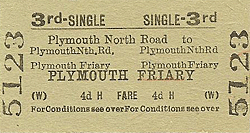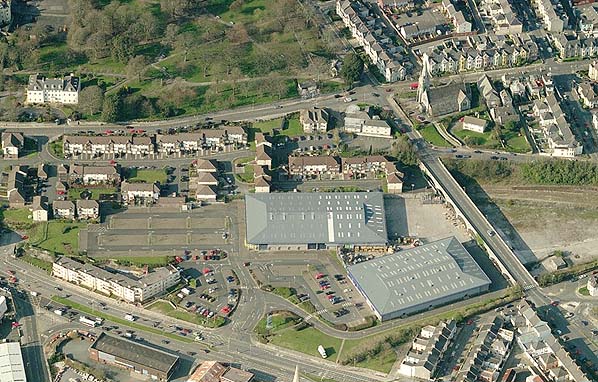Notes: The London and South Western Railway (LSWR) opened its terminus at Plymouth Friary on the 1st of July 1891 offering - at that time - a faster service to London than the Great Western Railway (GWR).
 |
The station was a rather grand with its building on the north side facing onto Beaumont Road complete with a glass-roofed canopy out on posts which provided cover for those arriving by horse and carriage. It had four platforms consisting of two long roads with bay platforms on the outer edges. Between the two long roads, there was a middle road/siding. Arrivals came |
into platform 1 (down bay) or platform 2, with departures from platforms 3 and 4 (up bay). There was also an up siding/dock next to platform 4. Although there was a loco release crossover from platform 2 into the middle road, platforms 1 and 2 were not signalled for up departures.
Goods facilities were significant with a large yard on the down side to the east of Tothill Road bridge - although the goods shed was to the west of Tothill Road bridge to the south of the station.
| A small loco shed was situated adjacent to the south of the station opening on 1st July 1891, but this was replaced in June 1908 with a large 3-road shed situated some distance out from the station close to Lucas Terrace Halt. This had a proper mechanical coaling stage and 50-foot turntable (larger engines turned on the Friary "A" Signal Box - Mount Gould |
 |
Junction - Cattewater Junction triangle). The shed closed on 6th May 1963 and the remaining four locos were transferred to Plymouth Laira.
 |
Train services were significant with several through trains to London each day and local services to Turnchapel, St Budeaux Victoria Road (all stations local service within Plymouth), and Tavistock/ Brentor on the main line to Okehampton, Exeter Central and Waterloo. All trains except those on the Turnchapel branch went via Plymouth North Road (GWR station) |
through which the LSWR had running powers.
NB. As at Exeter St. Davids, it was possible to see a train for London departing in both directions from Plymouth North Road.
Passenger trains
When the line opened in 1891, there were 7 through trains each weekday (to Okehampton, Exeter or London) plus 6 local trains. Added to this were 8 return journeys per day on the Turnchapel branch. In 1908, the number of return journeys to Turnchapel had risen to 28 showing the popularity of this local service.
By 1918, there were 11 through trains each way on weekdays in each direction with 3 down and 5 up through trains on Sundays. On top of this there were 7 down and 6 up local trains to Tavistock/Brentor with an additional service in each direction on Saturdays. Sundays saw 2 local trains to Tavistock. The Turnchapel branch had 24 trains on weekdays but none on Sundays. There were also 34 local all-stations services within Plymouth to Devonport Kings Road or St Budeaux Victoria Road mostly operated by Railmotor.
In Summer 1934, there were 13 through trains in the down direction with 15 in the up direction. Trains to Tavistock/Brentor had risen to 10 down and 9 up plus one extra service each way on Saturdays. On Sundays, Plymouth Friary was very busy with excursion trains to/from Padstow, |
 |
Bude, Ilfracombe and Exmouth - giving 15 down through trains and 14 up through trains. Tavistock got one local train on Sundays
Between 1941 and 1947, Friary was also host to the GWR branch line trains to Yealmpton - due to the severe bombing of the City of Plymouth during WW2. Shortly before closure Plymouth Friary came under the control of the Western Region of British Railways.
 |
By 1957, things had eased slightly with only 11 through trains in each direction on weekdays and 6 through trains each way on Sundays. By this time, the local services to Turnchapel and St Budeaux Victoria Road had ceased (Turnchapel in 1951) and Tavistock/Brentor had only 5 down and 7 up trains each weekday with one extra service each way on |
Saturdays but no local service on Sundays.
| Plymouth was one of the many destinations for the Atlantic Coast Express and was served every weekday by a portion of this train until it ceased running in 1964. Mention must also be made of the Devon Belle - an all Pullman train from Waterloo with portions for Plymouth (front portion) and Ilfracombe (rear portion including Pullman observation car). The |
 |
Plymouth portion consisted of 4 Pullman cars and ran between 1947 and 1950 - the Ilfracombe portion continuing to operate until 1954.
Freight
Although freight traffic from Plymouth Friary was heavy - including that from Sutton Harbour (a branch line which descended from the goods yard into a tunnel) and Cattewater Harbour - there is no indication that there were any particular traffic types.
 |
There were many freight trains each day to/from the large goods yard - in 1934 this was 7 down trains and 7 up trains each weekday, plus 5 trip workings each day to/from the GWR at Laira. The goods yard closed on 5th May 1963 reopening in 1966 as a concentration depot. The date of final closure is unknown but the track to the west of Tothill Road bridge was removed |
in the early 1990s but is still in place to the east side of the bridge and is used as a reversing point for freight trains on the Cattewater Branch which was still in use in 2006.
Plymouth Friary Locoshed Allocations
The loco shed at Plymouth Friary (shedcode 72D in BR days) always had a large allocation of locomotives for the significant number of through trains, local trains and freight trains.
In 1947 the allocation was : 4 x T9 4-4-0 tender engines
11 x tank engines of T1, M7, O2 and 757 classes
4 x B4 0-4-0T shunting engines
In 1950 the allocation was : 4 x West Country 4-6-2 tender engines
1 x N-Class 2-6-0 tender engine
13 x tank engines of T1, M7, O2 and 757 classes
4 x B4 0-4-0T shunting engines
In 1959 the allocation was : 3 x M7 0-4-4T
4 x O2 0-4-4T
4 x LMS 2-6-2T (Mickey Mouse)
Tickets from Michael Stewart, area map drawn by Alan Young
|

friary_old7.jpg)

friary_old3.jpg)
friary_old9.jpg)
old14.jpg)
friary14.jpg)
friary12.jpg)










old_thumb15.jpg)
friary_old_thumb11.jpg)
friary_old_thumb8.jpg)
old_thumb17.jpg)
friary_old_thumb5.jpg)
friary_old_thumb2.jpg)
friary_old_thumb1.jpg)
friary_old+thumb6.jpg)
friary_old_thumb10.jpg)
friary_old_thumb4.jpg)
old_thumb16.jpg)
friary_old_thumb13.jpg)
friary_old_thumb12.jpg)
friary_thumb1.jpg)











 Home Page
Home Page